Water features transform ordinary outdoor spaces into tranquil retreats that engage all the senses. The gentle sound of flowing water creates natural white noise that masks urban distractions while providing visual focal points that draw the eye and soothe the spirit. From contemporary geometric designs to rustic natural streams, water features offer endless possibilities for personalization. Modern homeowners increasingly recognize these installations as valuable investments that enhance property aesthetics, support local wildlife, and create peaceful sanctuaries for relaxation and meditation. Whether working with expansive gardens or compact patios, every space can accommodate some form of water feature that reflects personal style and complements existing landscape design elements.
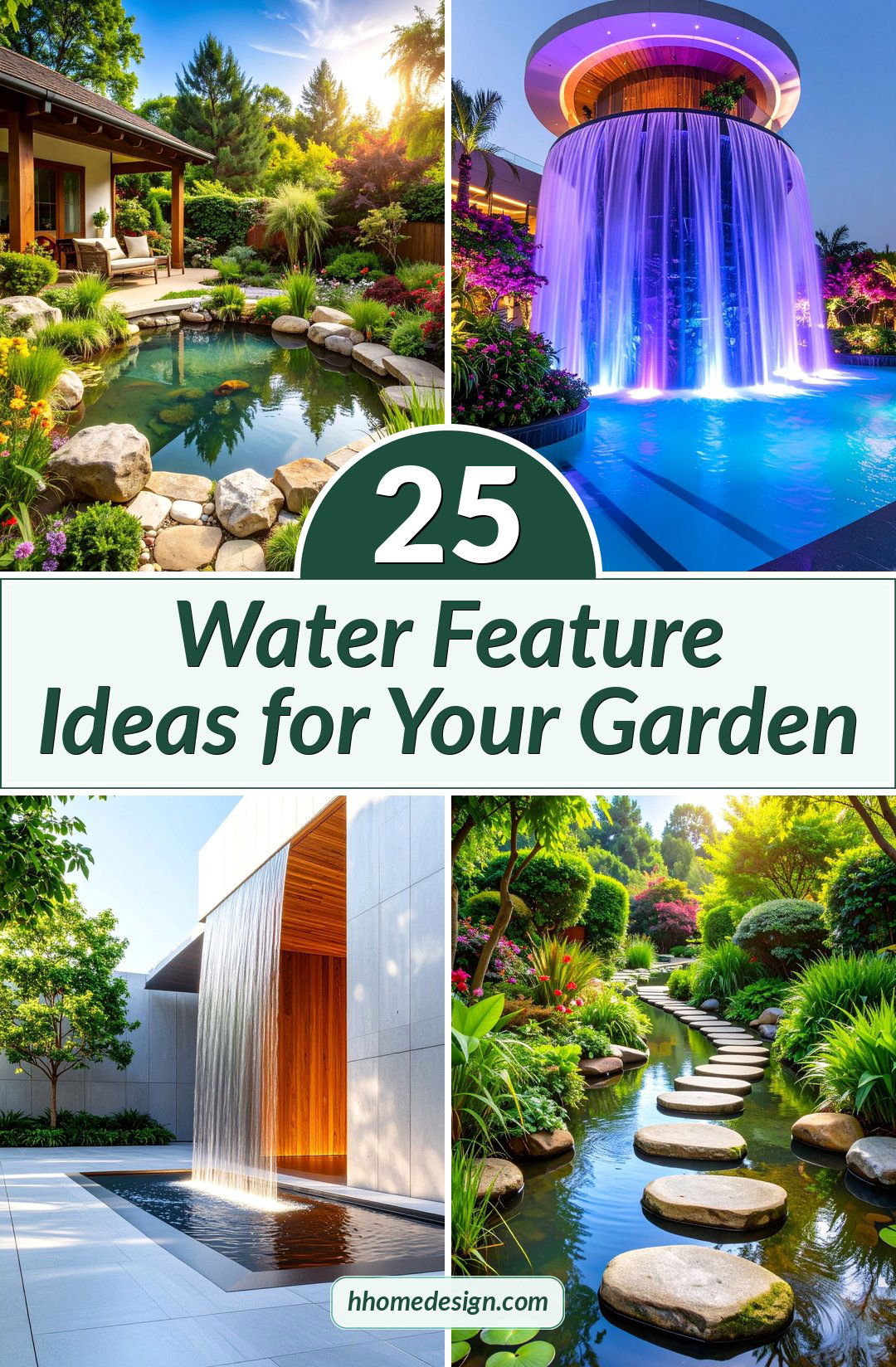
1. Contemporary Geometric Fountain with LED Integration
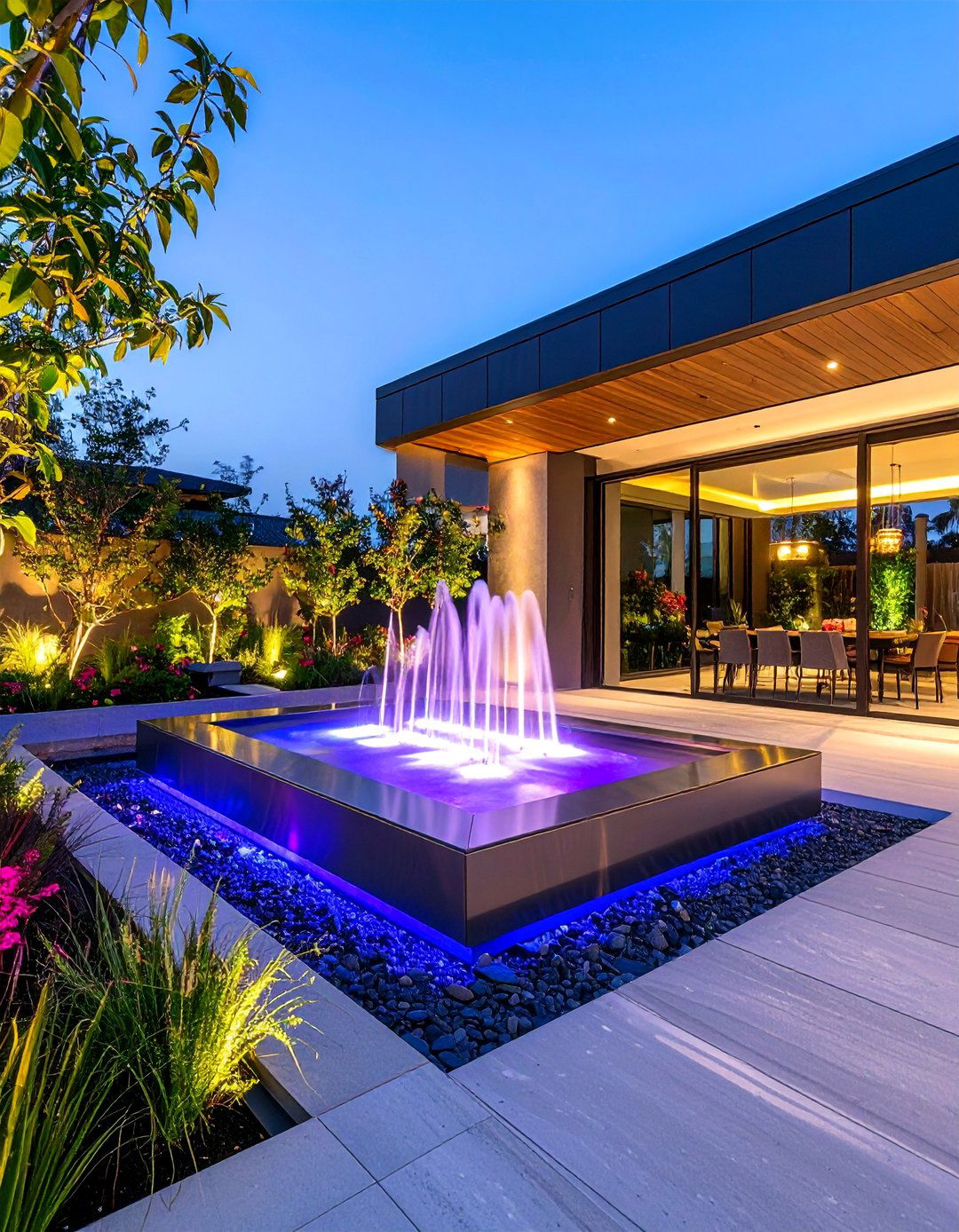
Contemporary geometric fountains showcase clean lines and minimalist aesthetics while incorporating cutting-edge lighting technology. These striking features typically employ rectangular, circular, or angular forms crafted from materials like brushed stainless steel, cast concrete, or composite stone. Water flows in controlled patterns over sleek surfaces, creating mesmerizing sheets or precise streams. Integrated LED lighting systems illuminate the water flow after dark, transforming the fountain into a dramatic nighttime focal point. The surrounding landscape complements the modern design with structured plantings, ornamental grasses, and hardscape elements in neutral tones. These fountains work exceptionally well in urban settings, contemporary gardens, and commercial spaces where architectural sophistication meets functional artistry.
2. Natural Stone Waterfall with Rock Garden Surround
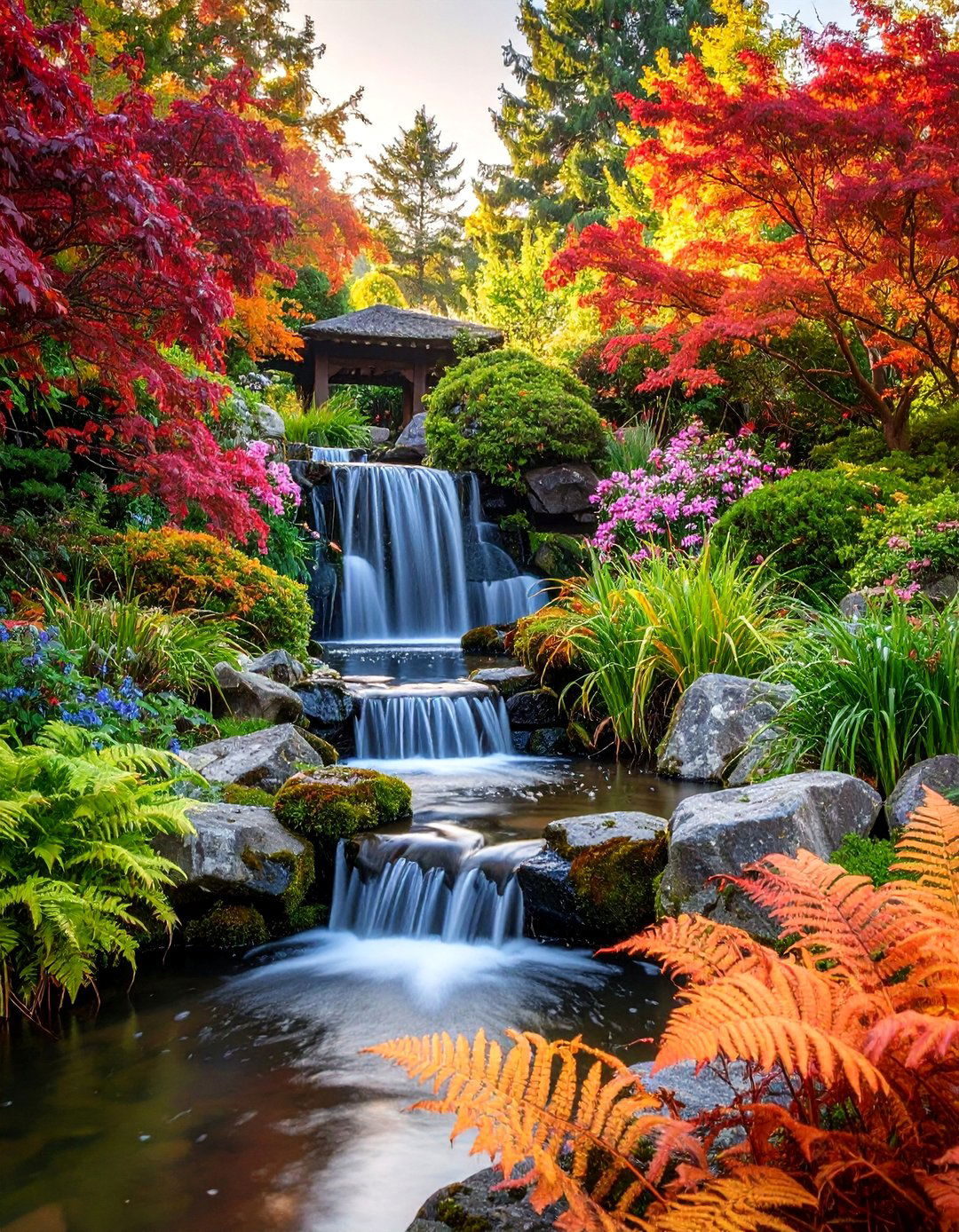
Natural stone waterfalls recreate the serene beauty of mountain streams within residential landscapes. Large boulders and carefully selected fieldstones form cascading tiers that guide water through multiple levels, creating varying sounds and visual textures. The surrounding rock garden features drought-tolerant plants, alpine species, and ornamental grasses that thrive in well-draining conditions. Native ferns, hostas, and moisture-loving perennials soften the hardscape edges while providing year-round interest. This design philosophy emphasizes organic placement that appears naturally occurring rather than artificially constructed. The recirculating system includes hidden pumps and filtration components that maintain water clarity while supporting beneficial bacteria. These installations blend seamlessly with existing topography and require minimal maintenance once established.
3. Solar-Powered Tiered Fountain with Planter Integration

Solar-powered tiered fountains combine sustainable energy solutions with multi-functional design elements that accommodate both water circulation and plant cultivation. The fountain structure incorporates graduated planter levels surrounding the central water feature, allowing for seasonal flower displays or herb gardens. Solar panels discretely positioned nearby capture sunlight to power recirculation pumps, eliminating electrical connections and reducing operating costs. Battery backup systems ensure consistent operation during cloudy periods. The planter tiers feature specialized drainage systems that prevent root damage while maintaining soil moisture through gentle overflow irrigation. Seasonal plantings create ever-changing color schemes that complement the water's reflective qualities. These eco-friendly installations appeal to environmentally conscious homeowners seeking sustainable landscape solutions that provide both aesthetic beauty and practical functionality.
4. Pondless Stream with Stepping Stone Pathway
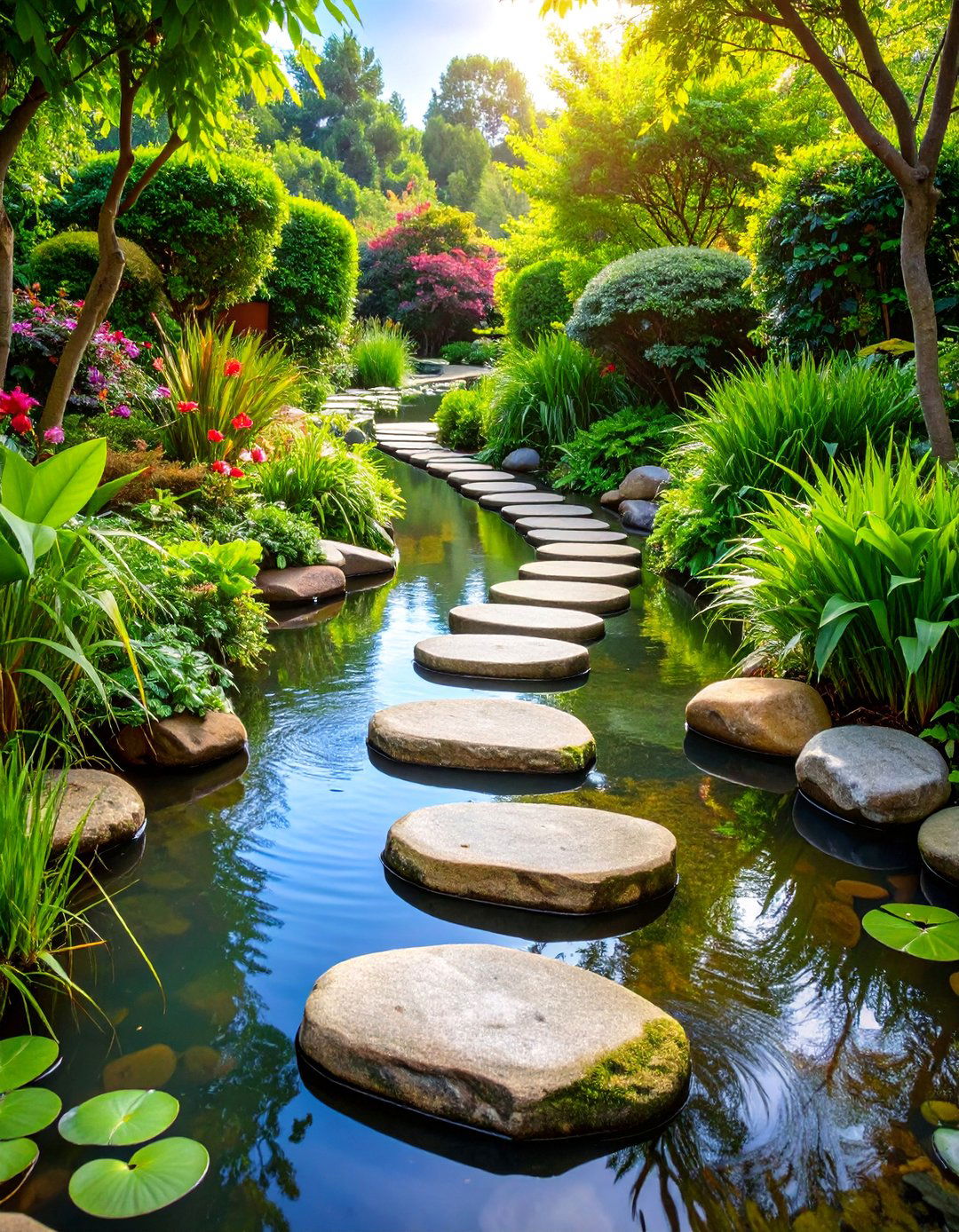
Pondless streams offer the appeal of flowing water without traditional pond maintenance requirements. These installations feature meandering watercourses that begin at elevated source points and disappear into underground collection systems. Natural stepping stones positioned strategically across the stream create interactive pathways that invite exploration and engagement. The streambed incorporates various rock sizes, creating turbulence that oxygenates the water and produces pleasant babbling sounds. Marginal plantings including water iris, cattails, and sedges enhance the naturalistic appearance while providing wildlife habitat. The recirculation system includes gravel filters and biological treatment components that maintain water quality. Underground reservoirs eliminate standing water concerns while supporting the continuous flow cycle. These features work beautifully in sloped terrain and complement informal garden designs.
5. Floating Solar Sphere with Illuminated Water Display

Floating solar spheres create mesmerizing water displays that combine spherical aesthetics with sustainable technology. These features consist of hollow, translucent orbs that float gracefully on pond or basin surfaces while housing integrated solar-powered pumps and LED lighting systems. Water shoots upward through central openings, creating fountain effects that change throughout the day based on solar energy availability. Evening illumination transforms the spheres into glowing focal points that cast dancing reflections across surrounding water surfaces. The spheres automatically adjust to changing water levels and weather conditions. Multiple spheres of varying sizes create dynamic compositions suitable for larger water features. These installations require minimal maintenance while providing maximum visual impact. They work particularly well in contemporary settings where technology meets artistic expression.
6. Rustic Wooden Water Wheel with Trough System

Rustic wooden water wheels evoke pastoral charm while creating functional water circulation systems reminiscent of historical mill operations. These features incorporate weather-resistant lumber construction with metal reinforcement components that ensure longevity in outdoor environments. Water flows from elevated sources onto wheel paddles, creating rotational motion that powers auxiliary pumps or simply provides kinetic visual interest. Accompanying wooden troughs collect and redirect water flow while serving as planters for seasonal displays. The surrounding landscape emphasizes cottage garden aesthetics with informal plantings, climbing vines, and weathered hardscape materials. Proper maintenance includes periodic wood treatment and mechanical component inspection. These installations complement farmhouse, cottage, and rustic architectural styles while providing educational opportunities about traditional water management techniques.
7. Mediterranean Ceramic Urn with Spillway Design

Mediterranean ceramic urns create elegant focal points that reference classical antiquity while providing soothing water sounds through carefully designed spillway systems. These features showcase large, decorative vessels crafted from terra cotta, glazed ceramic, or weather-resistant composite materials in earth tones that complement Mediterranean color palettes. Water emerges from urn openings and cascades down exterior surfaces into surrounding collection basins filled with decorative pebbles or smooth river stones. The surrounding landscape incorporates drought-tolerant plants like lavender, rosemary, olive trees, and ornamental grasses that thrive in Mediterranean climates. Hardscape elements include natural stone paving, gravel pathways, and low retaining walls that enhance the Old World atmosphere. These installations work beautifully in courtyards, patios, and formal garden settings.
8. Modern Water Wall with Vertical Garden Integration

Modern water walls combine architectural sophistication with living wall technology to create stunning vertical features that maximize limited space. These installations feature smooth panels of glass, stone, or metal down which water flows in controlled sheets, creating mirror-like surfaces and gentle sounds. Integrated planting systems positioned alongside or within the water wall structure support vertical gardens featuring air plants, small ferns, and other moisture-loving species. The recirculation system includes hidden reservoirs, high-efficiency pumps, and optional lighting systems that highlight both water flow and plant textures. Structural mounting systems ensure secure installation on existing walls or freestanding frames. These features work exceptionally well in contemporary settings, small gardens, and commercial applications where space efficiency meets aesthetic sophistication. Professional installation ensures proper drainage and structural integrity.
9. Japanese-Inspired Bamboo Fountain with Zen Garden Setting

Japanese-inspired bamboo fountains, or "shishi-odoshi," create meditative soundscapes through traditional design principles that emphasize simplicity and natural materials. These features incorporate hollow bamboo tubes that fill with water from continuous sources, tip when full, and strike stone or wood surfaces to produce distinctive hollow sounds. The surrounding zen garden includes raked gravel patterns, carefully placed stones, and minimal plantings that encourage contemplation and mindfulness. Traditional elements like stone lanterns, wooden bridges, and precisely pruned evergreens enhance the authentic atmosphere. The water source flows from elevated positions through bamboo channels or ceramic vessels, creating gentle gurgling sounds. These installations require understanding of Japanese aesthetic principles and attention to proportional relationships. They work beautifully in meditation spaces, tea gardens, and contemporary minimalist settings.
10. Victorian-Style Multi-Tier Cast Iron Fountain
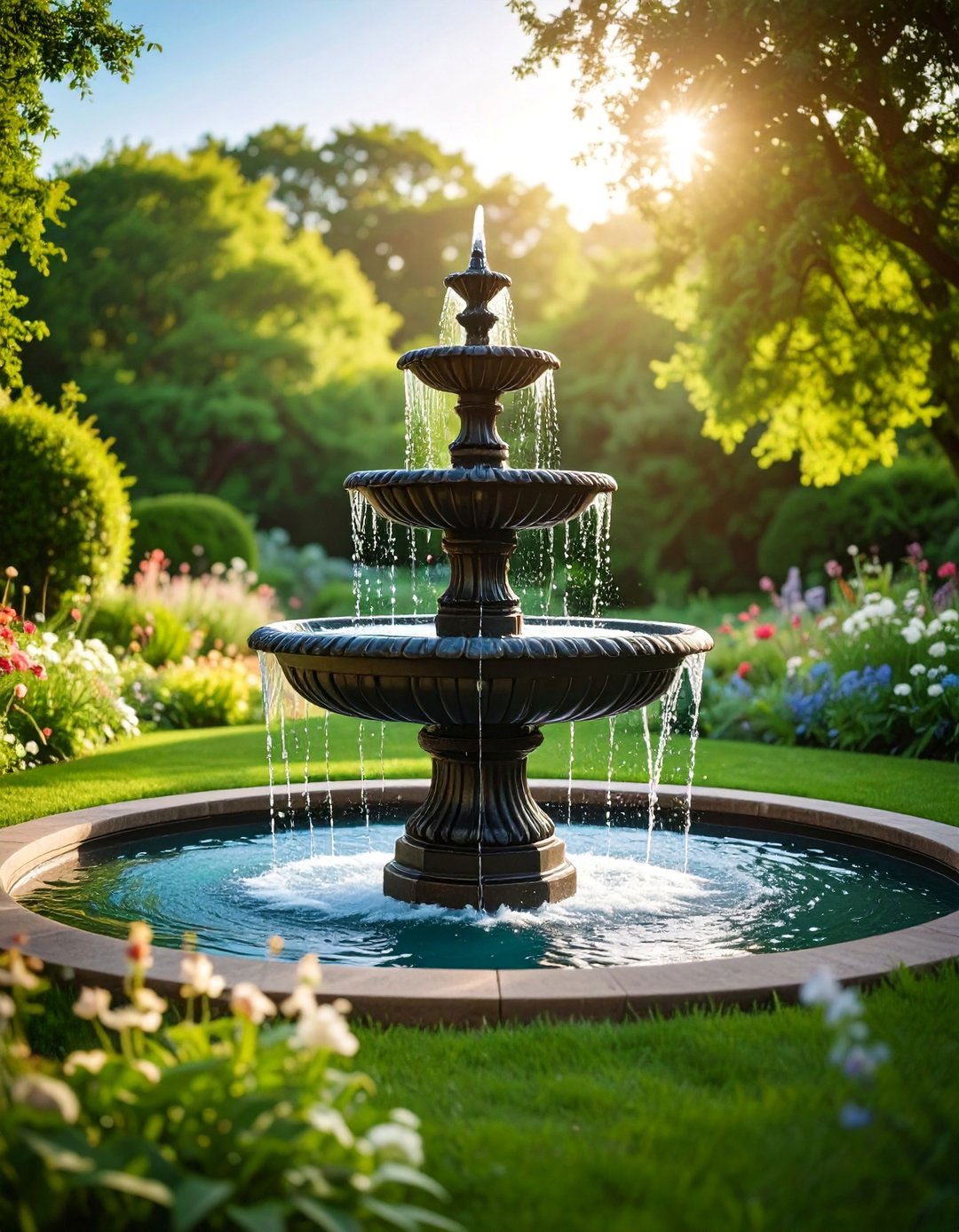
Victorian-style multi-tier cast iron fountains showcase ornate craftsmanship and classical proportions that reference historical garden design traditions. These elaborate features typically incorporate three or more graduated tiers supported by decorative columns or sculptural elements finished in traditional patinas or contemporary powder coatings. Water cascades from upper basins through carefully engineered spillways that create layered curtains and musical water sounds. Ornamental details include botanical motifs, scrollwork, and figurative elements that reflect period authenticity. The surrounding formal garden emphasizes symmetrical plantings, geometric pathways, and traditional materials like brick or natural stone. These fountains serve as commanding centerpieces in estate gardens, public spaces, and restoration projects. Professional installation ensures proper foundation support and plumbing connections. Regular maintenance preserves finish quality and mechanical operation.
11. Rain Chain Cascade with Collection Basin Display
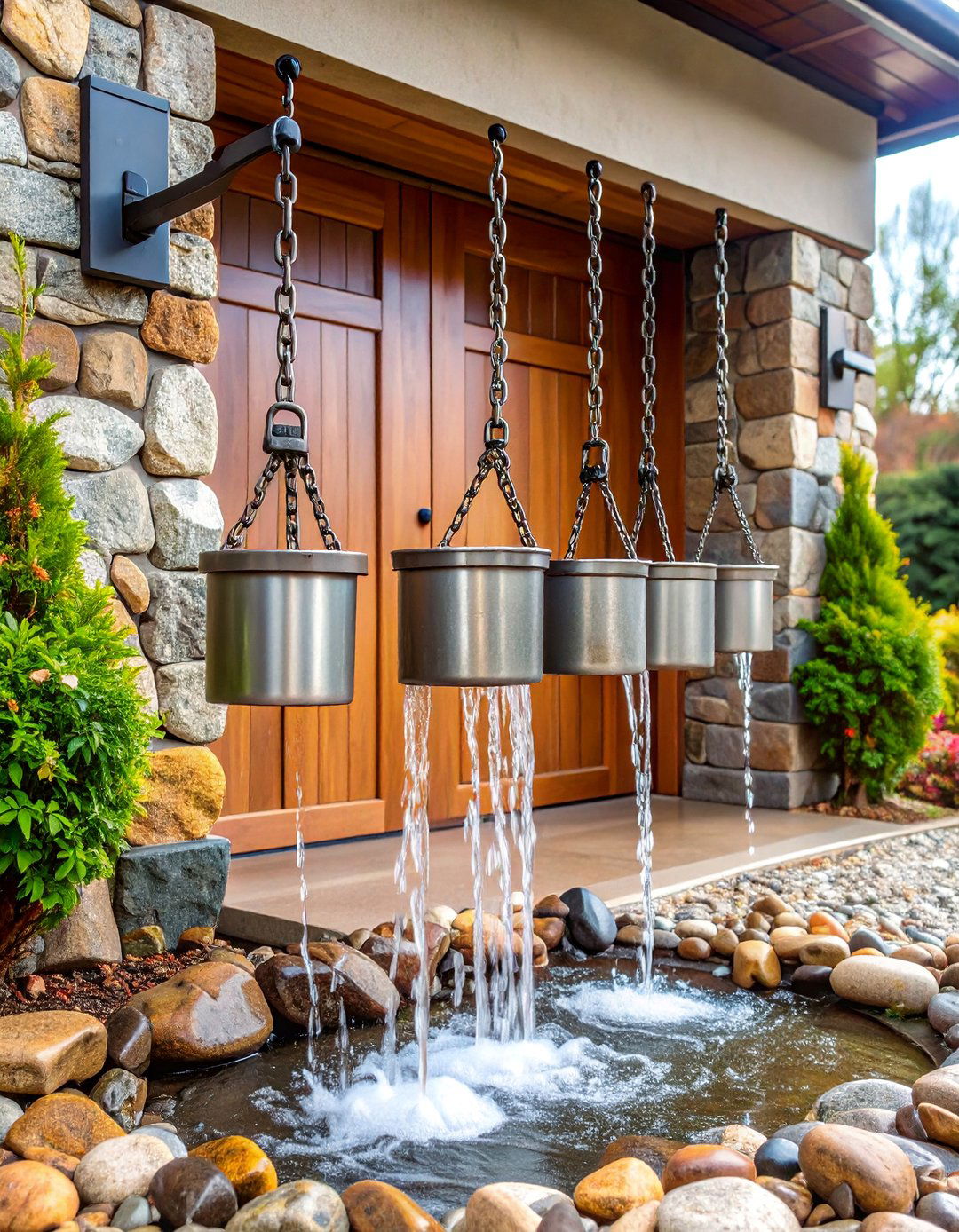
Rain chain cascades transform utilitarian gutter systems into artistic water features that celebrate precipitation while providing functional drainage solutions. These installations replace traditional downspouts with decorative metal chains, cups, or sculptural elements that guide rainwater through linked components, creating visible streams during weather events. Collection basins positioned beneath the rain chains capture and temporarily store water while featuring decorative elements like river stones, aquatic plants, or additional fountain components. The aesthetic appeal continues during dry periods through the sculptural qualities of the chain elements themselves. Materials include copper, aluminum, stainless steel, and artistic composites designed to weather naturally or maintain specific finishes. These features work particularly well in contemporary and traditional settings where architectural integration meets functional artistry.
12. Container Water Garden with Floating Features
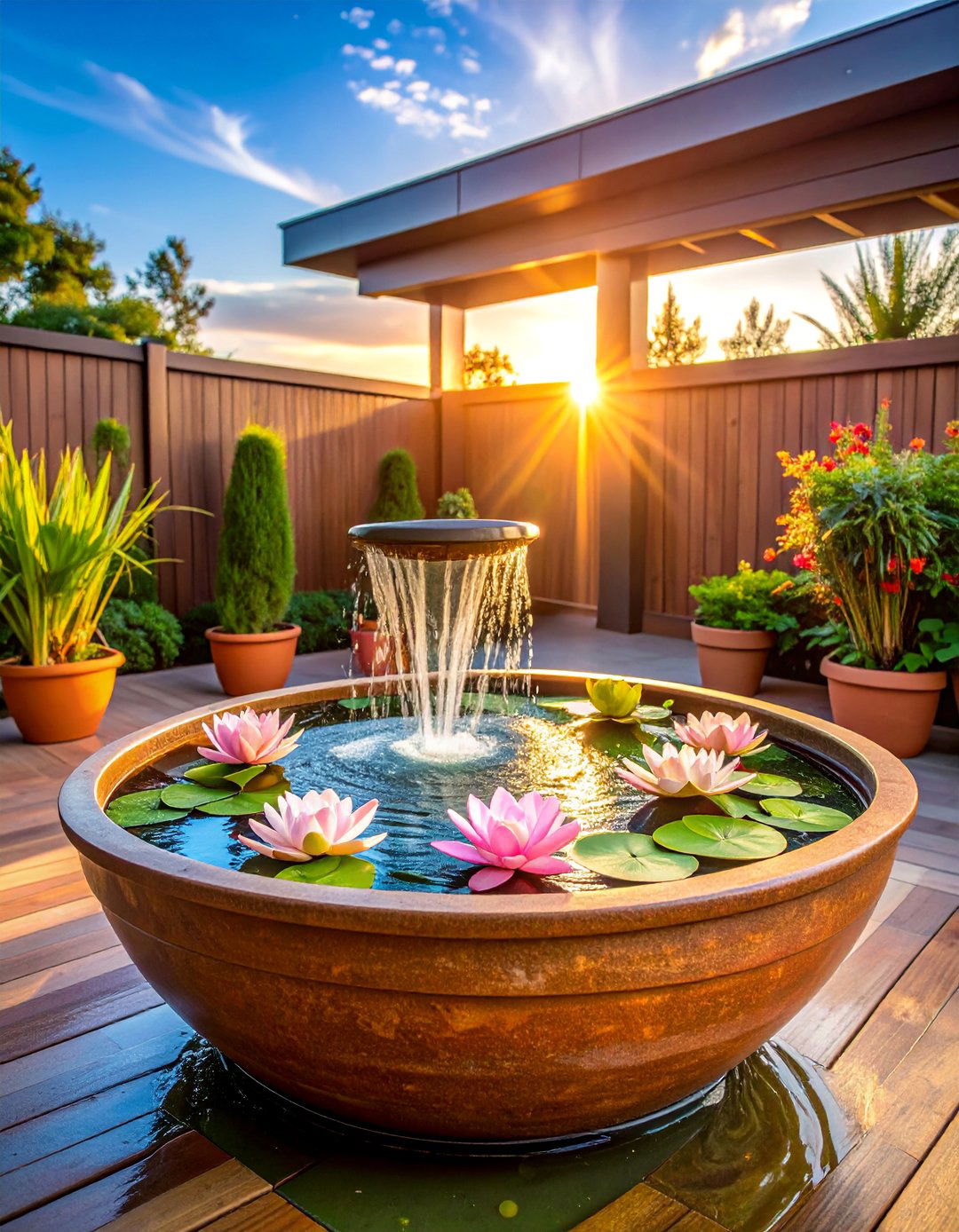
Container water gardens offer versatility and mobility while supporting complete aquatic ecosystems within large ceramic pots, wooden barrels, or decorative basins. These features incorporate floating plants like water lilies, lotus, or water hyacinth alongside submerged oxygenating species that maintain ecological balance. Additional floating elements include solar fountains, decorative spheres, or artistic sculptures that create surface interest and gentle water movement. The container size determines plant selection and fish compatibility, with larger vessels supporting goldfish or koi populations. Seasonal maintenance includes plant division, water quality monitoring, and winter protection in colder climates. These installations work beautifully on patios, decks, balconies, and small gardens where traditional ponds aren't feasible. Multiple containers create diverse aquatic displays that change throughout growing seasons.
13. Desert Succulent Fountain with Drought-Tolerant Landscaping
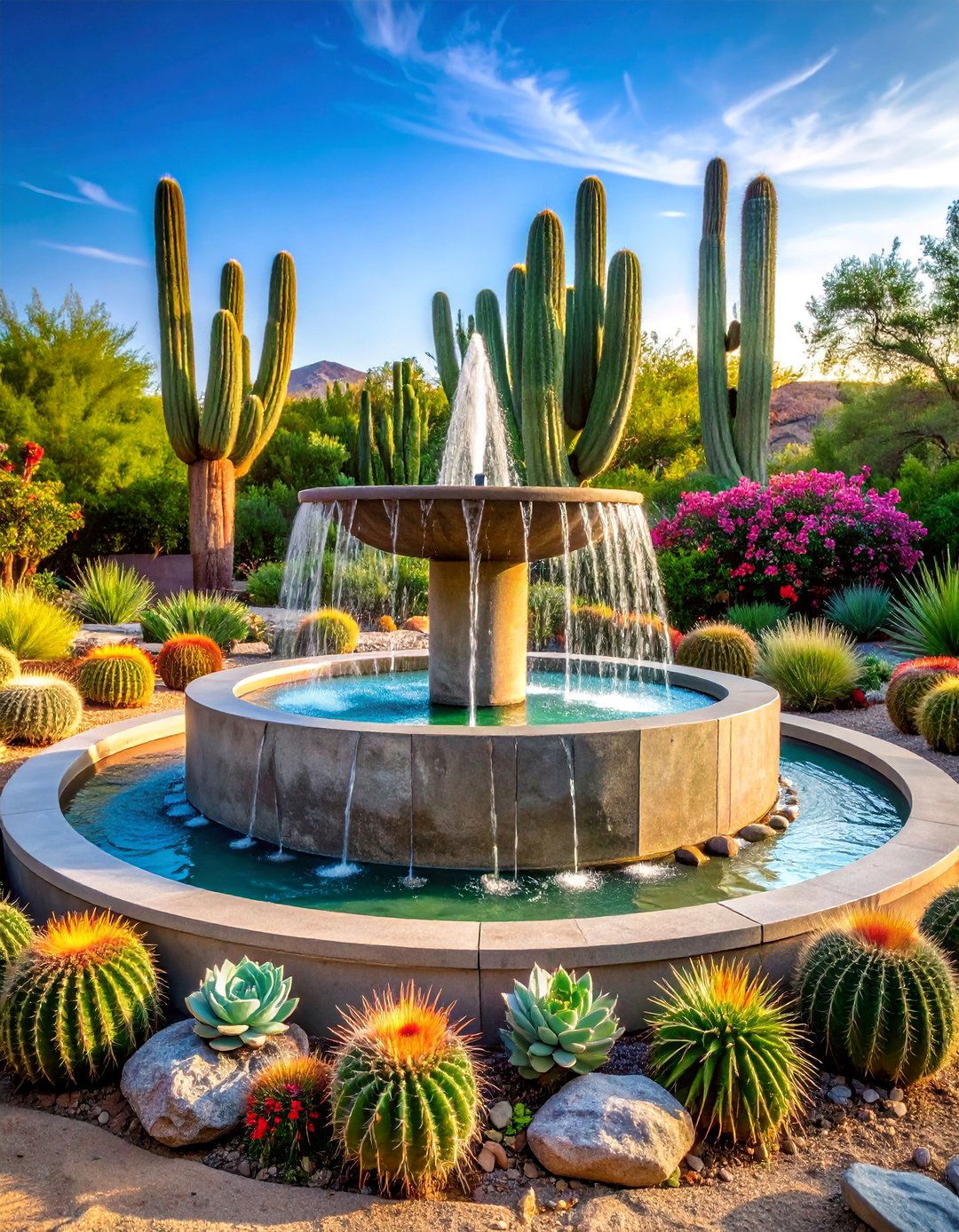
Desert succulent fountains combine water features with drought-tolerant landscaping principles to create sustainable installations suitable for arid climates and water-conscious homeowners. These designs incorporate geometric forms, natural stone materials, and minimal water requirements while maximizing visual and auditory impact. The fountain structure features clean lines crafted from materials like stacked slate, cast concrete, or metal components that complement desert aesthetics. Surrounding plantings emphasize sculptural succulents, cacti, and ornamental grasses arranged in naturalistic compositions. Efficient recirculation systems minimize water loss through evaporation while creating gentle sounds that mask urban noise. The hardscape includes decomposed granite pathways, boulder accents, and gravel mulches that require minimal irrigation. These installations celebrate southwestern design traditions while addressing contemporary environmental concerns.
14. Bubble Rock Formation with Underwater Lighting

Bubble rock formations create fascinating geological displays where water emerges mysteriously from seemingly solid stone surfaces, suggesting natural springs or geothermal activity. These features incorporate specially drilled boulders or constructed rock formations with hidden pumps that force water through central openings, creating bubbling effects and gentle overflows. Underwater LED lighting systems positioned within the water basin illuminate the bubble action and rock textures, creating dramatic nighttime displays. The surrounding landscape emphasizes natural stone placement, ornamental grasses, and plants that thrive in moist conditions. Various rock types including granite, sandstone, and volcanic materials offer different aesthetic possibilities. These installations require careful pump sizing to achieve desired bubble intensity while maintaining energy efficiency. They work beautifully as focal points in natural gardens, zen spaces, and contemporary landscapes.
15. Herb Garden Fountain with Culinary Plant Integration
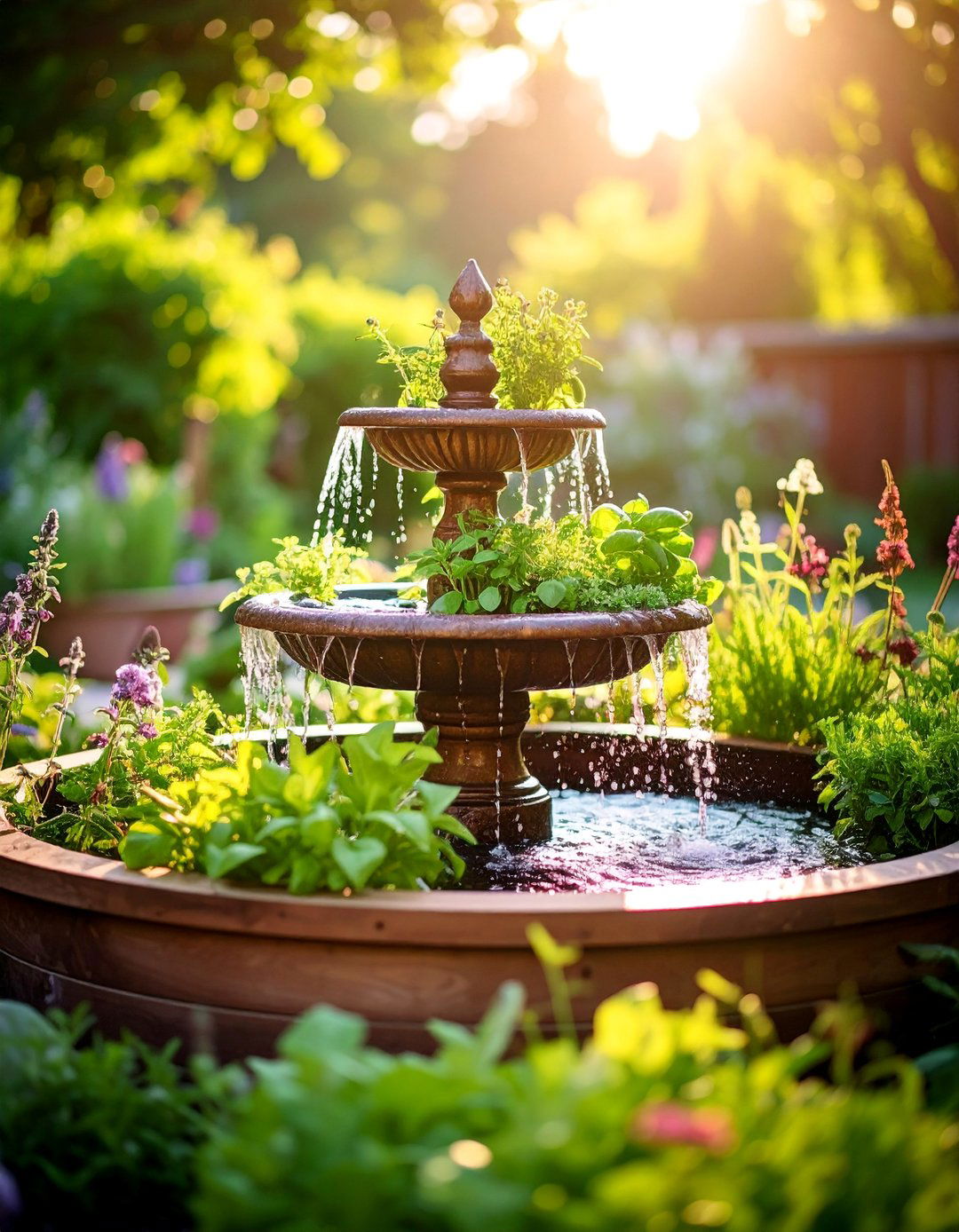
Herb garden fountains combine aromatic plant cultivation with water feature aesthetics to create functional installations that serve both culinary and ornamental purposes. These designs typically feature raised planters or terraced systems that incorporate herbs like basil, mint, oregano, and thyme alongside water circulation elements. The fountain structure provides consistent moisture for herb cultivation while creating pleasant sounds and visual focal points. Seasonal planting rotations ensure continuous harvests while maintaining garden beauty throughout growing periods. The water system includes gentle overflow irrigation that supplements natural rainfall without overwatering sensitive species. Materials include food-safe containers, untreated wood, and stone elements that won't contaminate edible plants. These installations work particularly well near outdoor kitchens, dining areas, and kitchen windows where fresh herbs are most convenient. They appeal to gardeners seeking both aesthetic and practical landscape solutions.
16. Architectural Blade Fountain with Minimalist Surround

Architectural blade fountains represent cutting-edge water feature design through ultra-thin water sheets that create mirror-like surfaces and sophisticated visual effects. These installations feature precision-engineered spillways that produce laminar water flow across metal, glass, or stone surfaces without turbulence or splashing. The minimalist aesthetic emphasizes geometric forms, neutral colors, and clean proportions that complement contemporary architecture. Surrounding landscapes feature structural plantings, geometric hardscapes, and carefully edited plant palettes that avoid competing with the fountain's sophisticated simplicity. The recirculation system incorporates high-efficiency pumps and filtration components that maintain crystal-clear water quality essential for optimal visual effects. Professional installation ensures precise leveling and proper water flow characteristics. These features work exceptionally well in modern residential settings, corporate environments, and architectural showcases where design innovation meets functional artistry.
17. Wildlife-Friendly Pond with Native Plant Ecosystem

Wildlife-friendly ponds prioritize ecological function while creating beautiful water features that support local fauna including birds, amphibians, and beneficial insects. These installations incorporate shallow entry areas, varied depth zones, and extensive plantings of native aquatic and marginal species that provide food and shelter. The design philosophy emphasizes natural processes over mechanical filtration, allowing beneficial bacteria and plant communities to maintain water quality. Features include log basking areas, stone pile hibernation sites, and overhanging vegetation that creates security for wildlife visitors. The surrounding buffer zone incorporates native wildflowers, grasses, and shrubs that extend habitat benefits beyond the water's edge. Seasonal management includes selective plant maintenance and minimal intervention approaches that preserve ecological relationships. These installations appeal to environmentally conscious homeowners seeking landscape features that contribute positively to local biodiversity while providing personal enjoyment and educational opportunities.
18. Vintage Pump Station with Nostalgic Garden Design
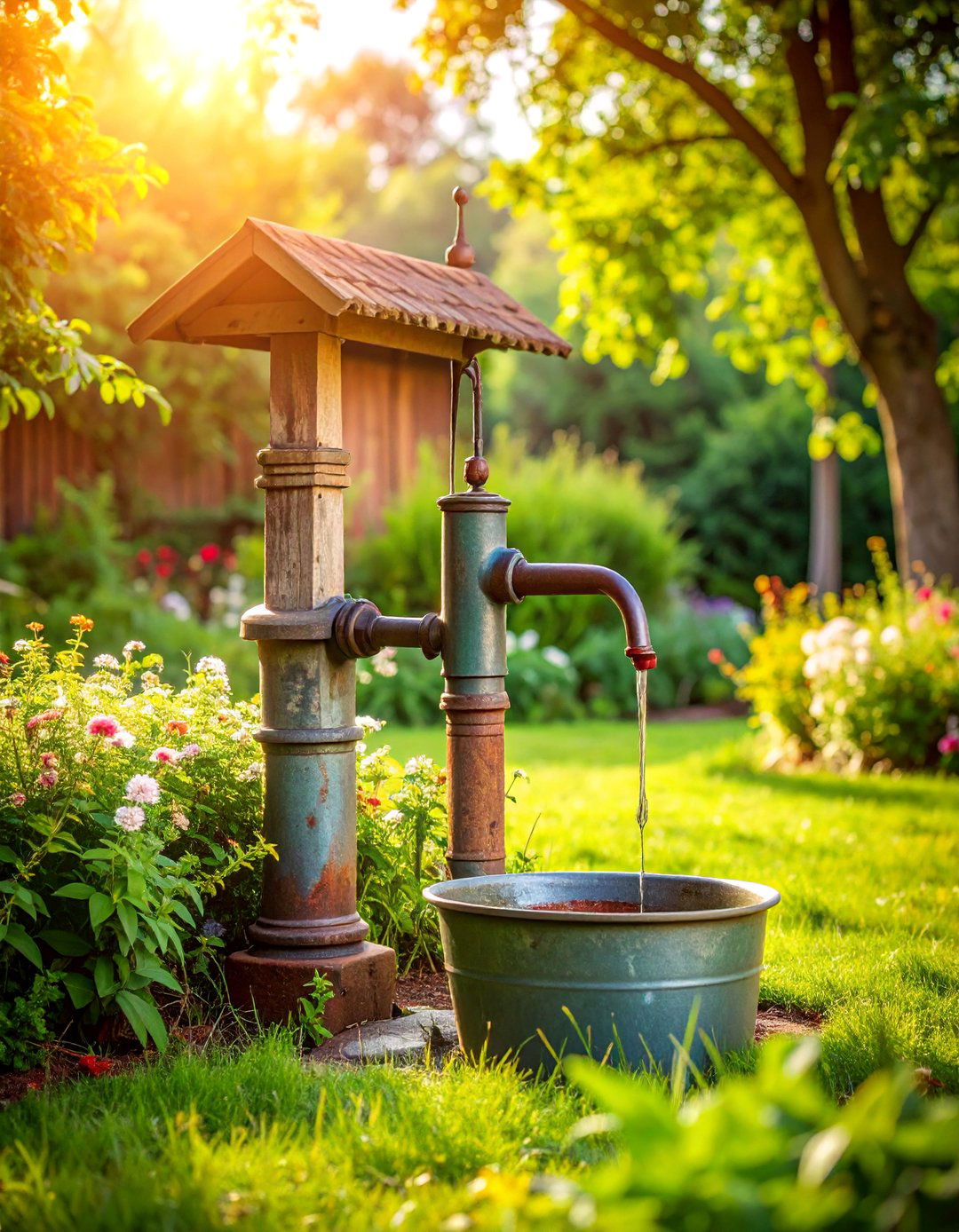
Vintage pump stations recreate historical water distribution systems while serving as functional fountain centerpieces in gardens that celebrate agricultural and industrial heritage. These features incorporate authentic or reproduction hand pumps, windmill components, and galvanized hardware that reference rural water management traditions. The surrounding landscape emphasizes heirloom plant varieties, cottage garden aesthetics, and informal design principles that complement the nostalgic atmosphere. Functional elements include working pump mechanisms, water troughs, and collection systems that demonstrate traditional water handling methods. Materials include weathered wood, galvanized metal, and natural stone components that develop appealing patinas over time. Educational opportunities arise from demonstrations of historical water management techniques. These installations work particularly well in heritage gardens, farmhouse settings, and educational landscapes where historical preservation meets contemporary functionality. They appeal to gardeners interested in preserving agricultural traditions while creating unique landscape features.
19. Illuminated Glass Waterfall with Color-Changing Technology

Illuminated glass waterfalls combine transparent materials with advanced lighting systems to create spectacular water displays that change throughout the day and evening hours. These installations feature specially designed glass panels down which water flows in controlled sheets while LED systems provide color-changing illumination that transforms the water's appearance. The technology allows for programmable lighting sequences that respond to seasons, holidays, or personal preferences. Structural mounting systems ensure secure installation while concealing electrical components and control systems. The surrounding landscape emphasizes plants and materials that complement the contemporary aesthetic without competing with the dramatic lighting effects. Professional installation ensures proper electrical connections, drainage systems, and safety considerations. These features work beautifully in modern residential settings, commercial properties, and entertainment areas where technological sophistication meets artistic expression. They represent the intersection of water feature design and smart home technology.
20. Terraced Garden Stream with Edible Landscape Integration

Terraced garden streams combine water management with food production to create functional landscapes that address both aesthetic and practical needs. These installations incorporate graduated planting levels that utilize stream overflow for irrigation while producing herbs, vegetables, and fruits. The water flow provides consistent moisture for cultivation while creating pleasant sounds and visual interest throughout the growing season. Terraced construction manages slope effectively while preventing erosion and maximizing planting space. Materials include stone retaining walls, wooden raised beds, and permeable pathway surfaces that handle water overflow safely. Plant selection emphasizes edibles that thrive in moist conditions including watercress, mint, and various greens. The system includes seasonal management for crop rotation and water flow adjustment. These installations appeal to gardeners seeking sustainable landscape solutions that produce food while conserving water and creating beauty. They work particularly well in sloped terrain and permaculture-inspired gardens.
21. Zen Reflecting Pool with Floating Meditation Platform

Zen reflecting pools emphasize contemplative stillness through mirror-like water surfaces that capture sky reflections and seasonal changes while supporting meditation and mindfulness practices. These installations feature geometric forms with precise edges and minimal plantings that avoid disturbing the water's reflective qualities. Floating meditation platforms constructed from weather-resistant materials provide comfortable seating positions surrounded by water's calming influence. The surrounding landscape incorporates zen garden principles including raked gravel areas, carefully placed stones, and minimal plant selections that encourage focused attention. The water system maintains consistent levels through discrete pumps and overflow systems that preserve the illusion of natural stillness. Professional installation ensures proper excavation, liner placement, and structural support for floating elements. These features work beautifully in contemporary settings, meditation gardens, and therapeutic landscapes where tranquility and spiritual contemplation are primary objectives. They require understanding of zen aesthetic principles and commitment to minimal maintenance approaches.
22. Recycled Material Fountain with Sustainable Design Focus
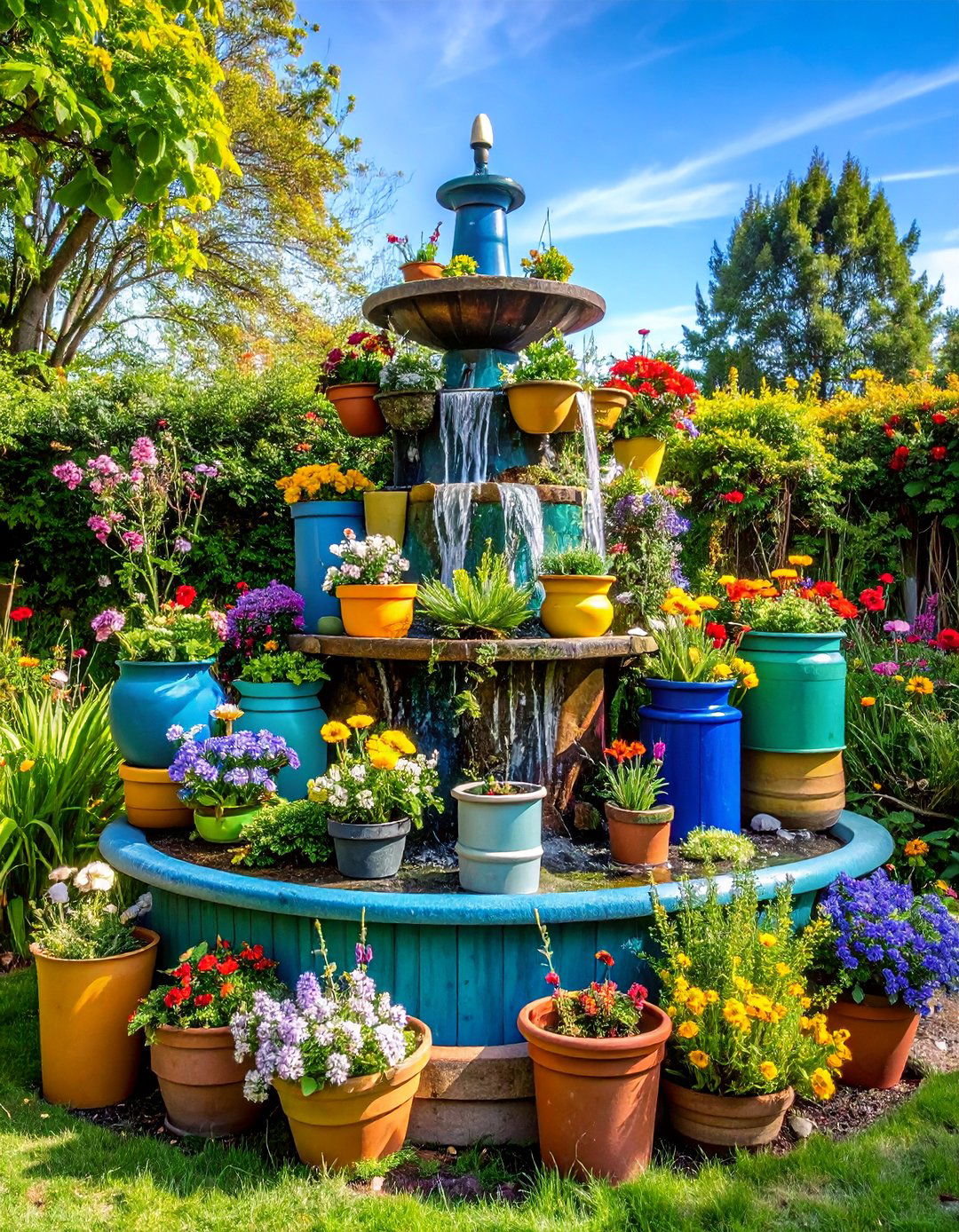
Recycled material fountains demonstrate creative reuse while addressing environmental concerns through innovative applications of reclaimed components. These installations incorporate materials like repurposed metal containers, salvaged stone, recycled glass, and reclaimed wood components that reduce waste while creating unique aesthetic expressions. The design process emphasizes creative problem-solving and artistic vision over conventional materials and methods. Examples include fountain systems created from old bathtubs, industrial containers, architectural salvage, and artistic assemblages that reference historical or cultural themes. The water circulation systems utilize energy-efficient pumps and sustainable practices that minimize environmental impact. Surrounding landscapes often incorporate native plants, permeable surfaces, and other sustainable design principles that complement the recycling theme. These installations appeal to environmentally conscious homeowners seeking landscape features that reflect personal values while creating distinctive garden focal points. They require creativity, technical skill, and commitment to sustainable practices.
23. Multi-Level Deck Fountain with Architectural Integration

Multi-level deck fountains integrate water features directly into elevated outdoor living spaces, creating seamless transitions between architectural elements and landscape design. These installations incorporate fountain components within deck construction, utilizing level changes to create cascading water effects between platform areas. The design requires careful coordination between fountain systems and structural framing to ensure proper drainage, waterproofing, and access for maintenance. Materials include composite decking, stainless steel water features, and integrated lighting systems that enhance both safety and aesthetics. The water circulation system includes hidden pumps, discrete reservoirs, and overflow protection that preserves structural integrity. Professional installation ensures proper building codes compliance and waterproofing details. These features work particularly well in contemporary homes where outdoor entertainment areas require distinctive focal points. They represent sophisticated integration of water features with architectural design, appealing to homeowners seeking seamless indoor-outdoor living experiences that incorporate water's calming influence.
24. Seasonal Display Fountain with Changeable Themed Elements

Seasonal display fountains incorporate interchangeable decorative elements that transform appearance throughout the year while maintaining consistent water circulation and structural integrity. These installations feature modular components that accommodate holiday decorations, seasonal plantings, and thematic displays that reflect changing seasons and personal celebrations. The base fountain structure provides reliable water circulation while supporting various decorative additions including seasonal sculptures, plant containers, lighting elements, and artistic installations. The design process emphasizes flexibility and accessibility for regular changes without disrupting water system operation. Storage solutions for seasonal elements require weatherproof containers and organized systems that facilitate easy transitions. These features appeal to homeowners who enjoy decorating and celebrating seasonal changes through landscape design. They work particularly well in entry gardens, patio areas, and locations where seasonal displays create welcoming atmospheres. The concept combines water feature benefits with decorative flexibility that keeps gardens interesting throughout the year.
25. Indoor-Outdoor Transition Fountain with Climate Adaptability

Indoor-outdoor transition fountains create seamless connections between interior and exterior spaces while adapting to varying climate conditions through portable or convertible design features. These installations utilize lightweight materials, modular construction, and weather-resistant components that allow seasonal relocation or protection during extreme weather events. The design emphasizes compact proportions suitable for both interior spaces and outdoor patios, decks, or garden areas. Features include removable reservoirs, adjustable pumps, and protective covers that extend operating seasons and preserve investment value. The aesthetic appeals to contemporary tastes through clean lines, neutral colors, and materials that complement both interior and exterior design schemes. Professional consultation ensures proper electrical requirements, drainage considerations, and safety features for dual-purpose installations. These features work particularly well in urban environments, small spaces, and climates with extreme seasonal variations. They represent innovative approaches to water feature design that address contemporary lifestyle needs for flexibility and year-round enjoyment.
Conclusion:
Water features offer transformative potential for any outdoor space, from expansive estates to intimate patios. The 25 ideas presented demonstrate the remarkable diversity available to homeowners seeking to incorporate water's soothing presence into their landscapes. Whether drawn to contemporary sophistication, natural aesthetics, or innovative sustainable solutions, each concept provides complete design themes that address both functional and aesthetic considerations. Success depends on matching feature selection to site conditions, maintenance capabilities, and personal preferences while considering long-term enjoyment and property enhancement. These installations represent investments in daily well-being, environmental stewardship, and landscape beauty that continue providing benefits for years to come.


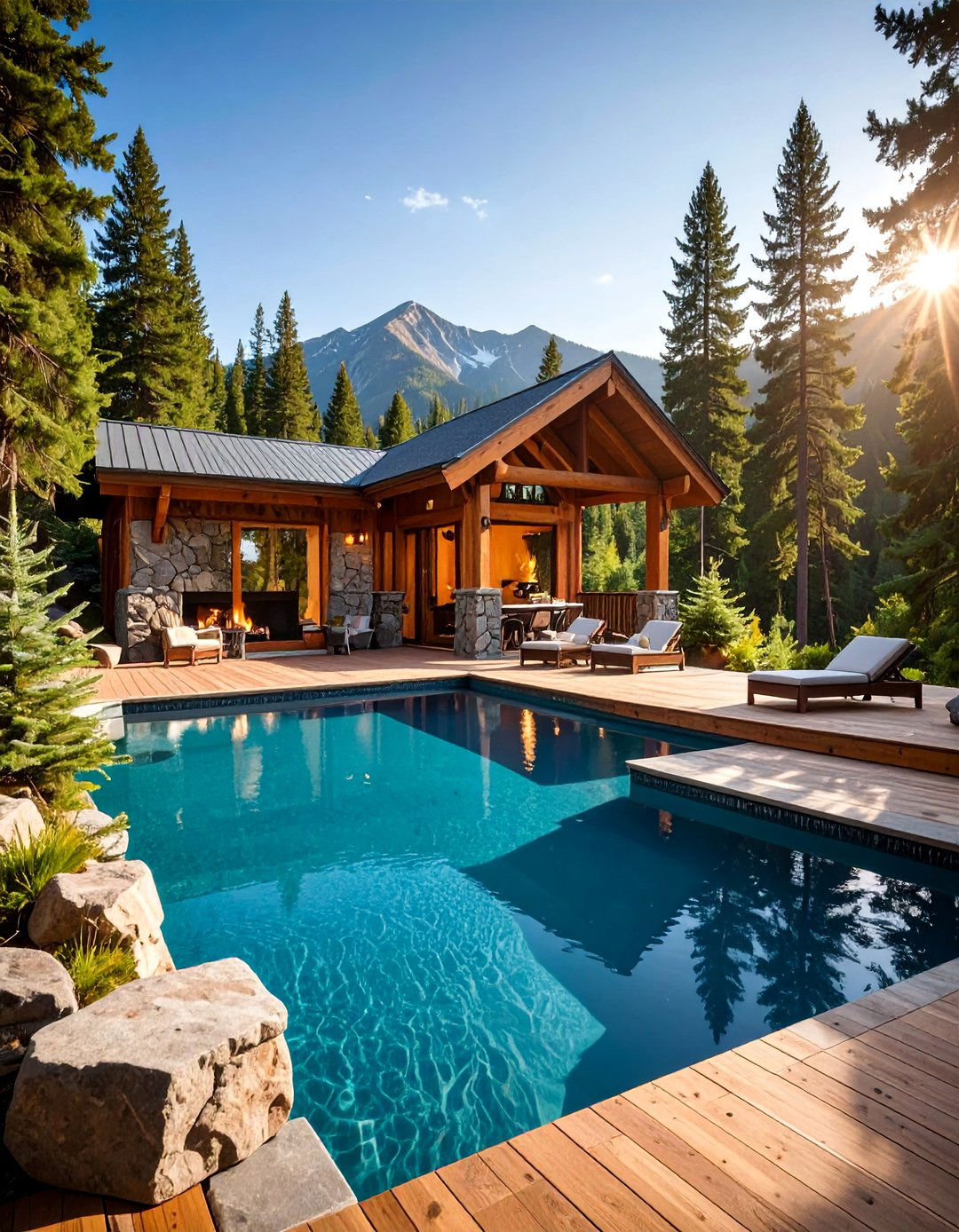

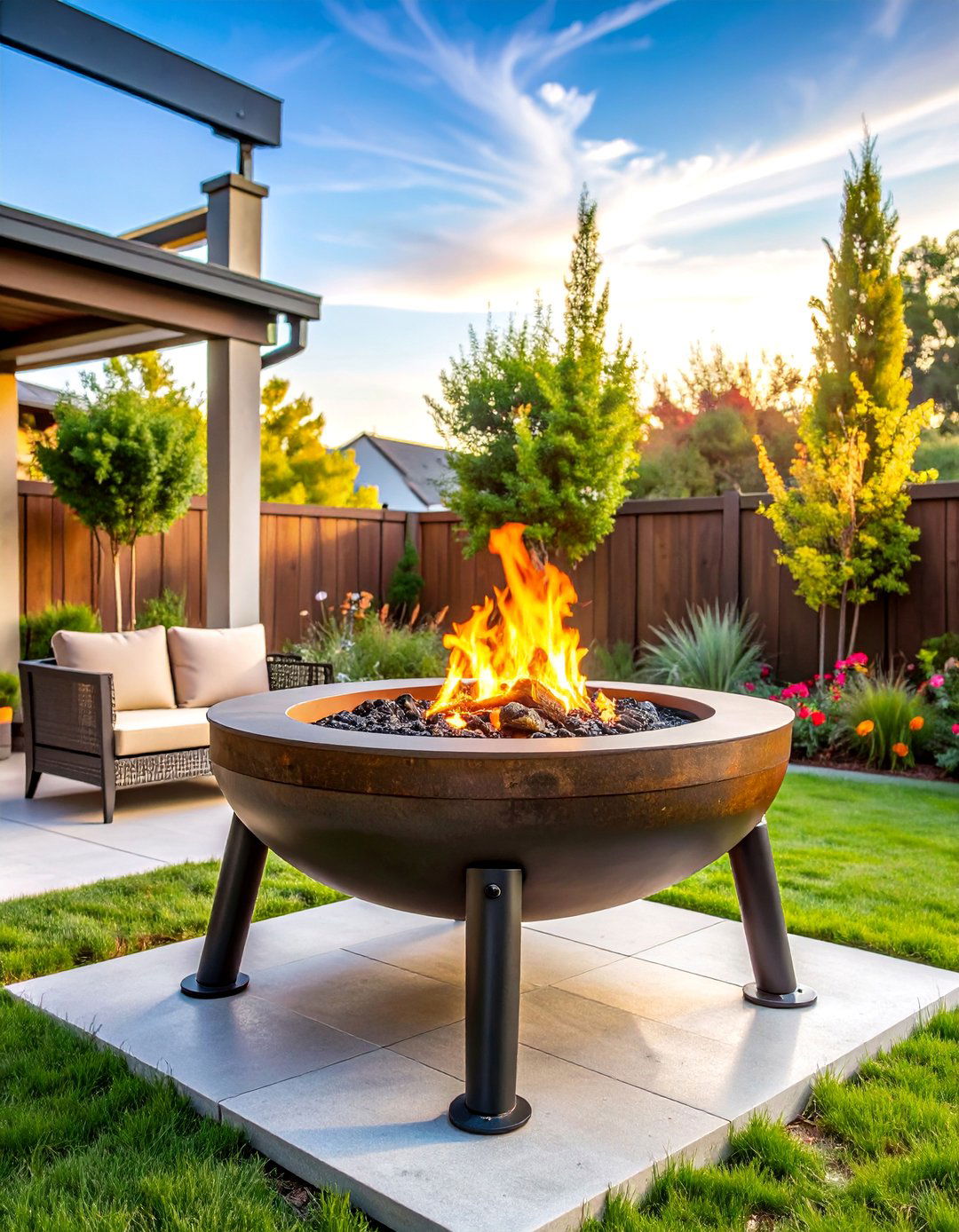

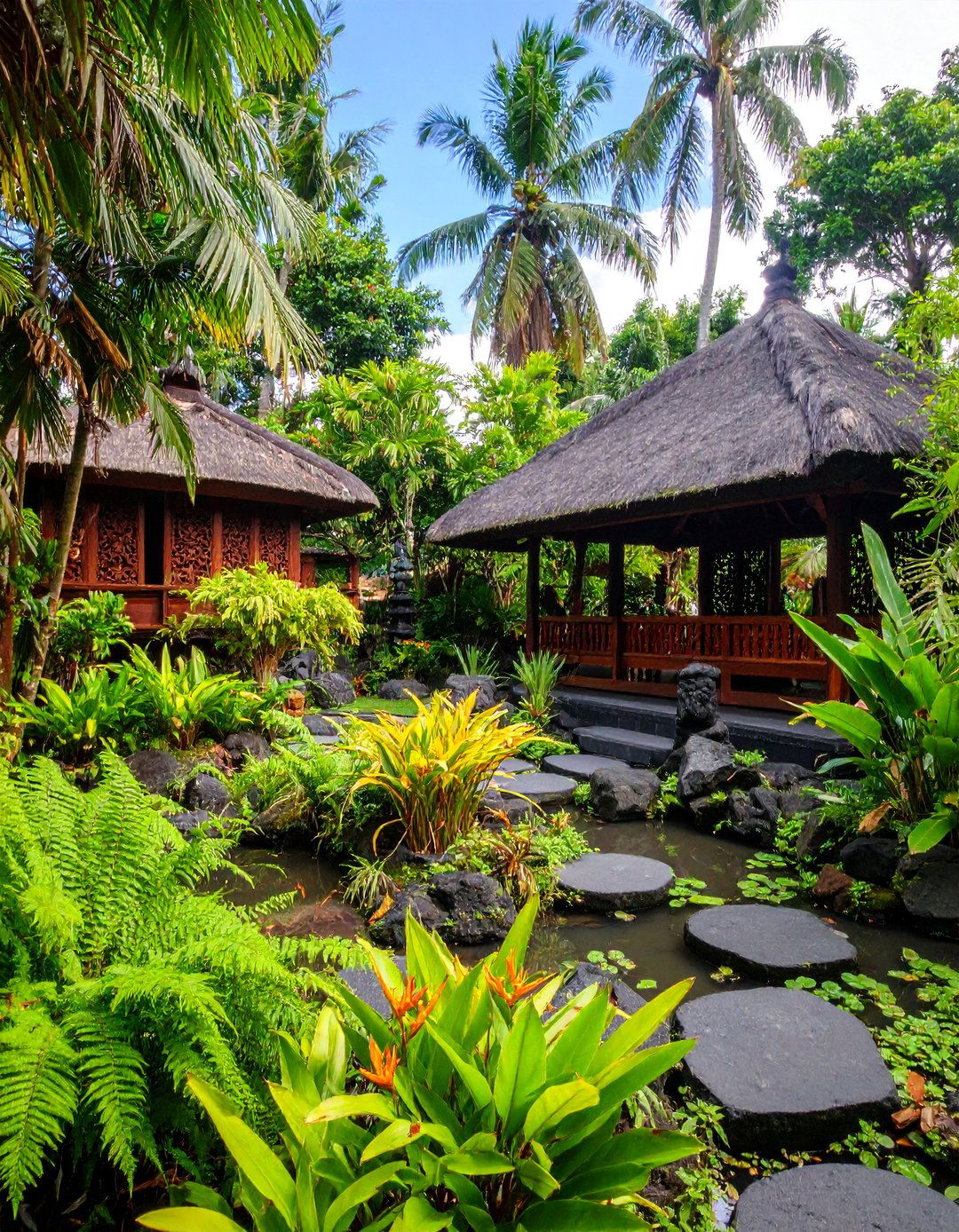



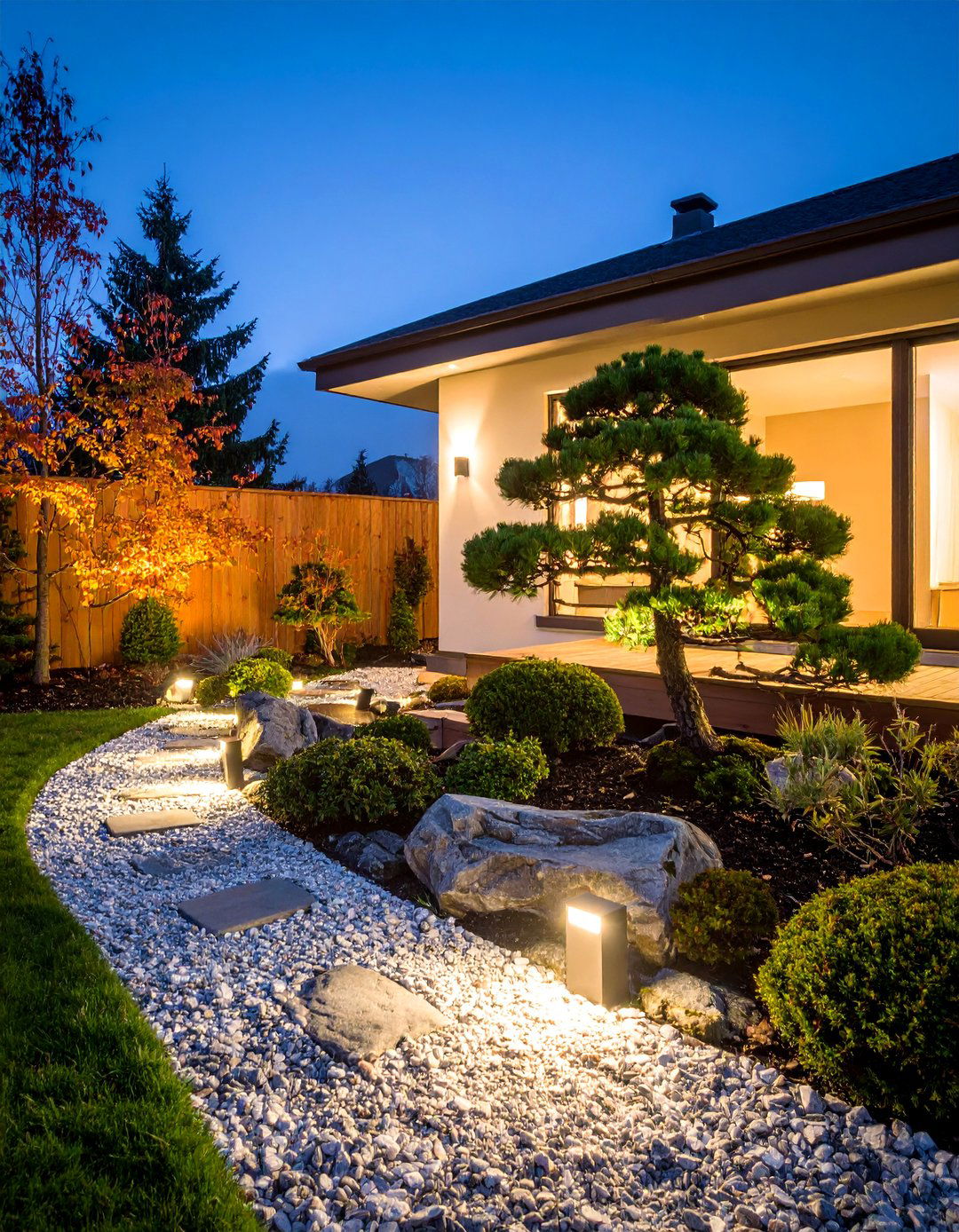

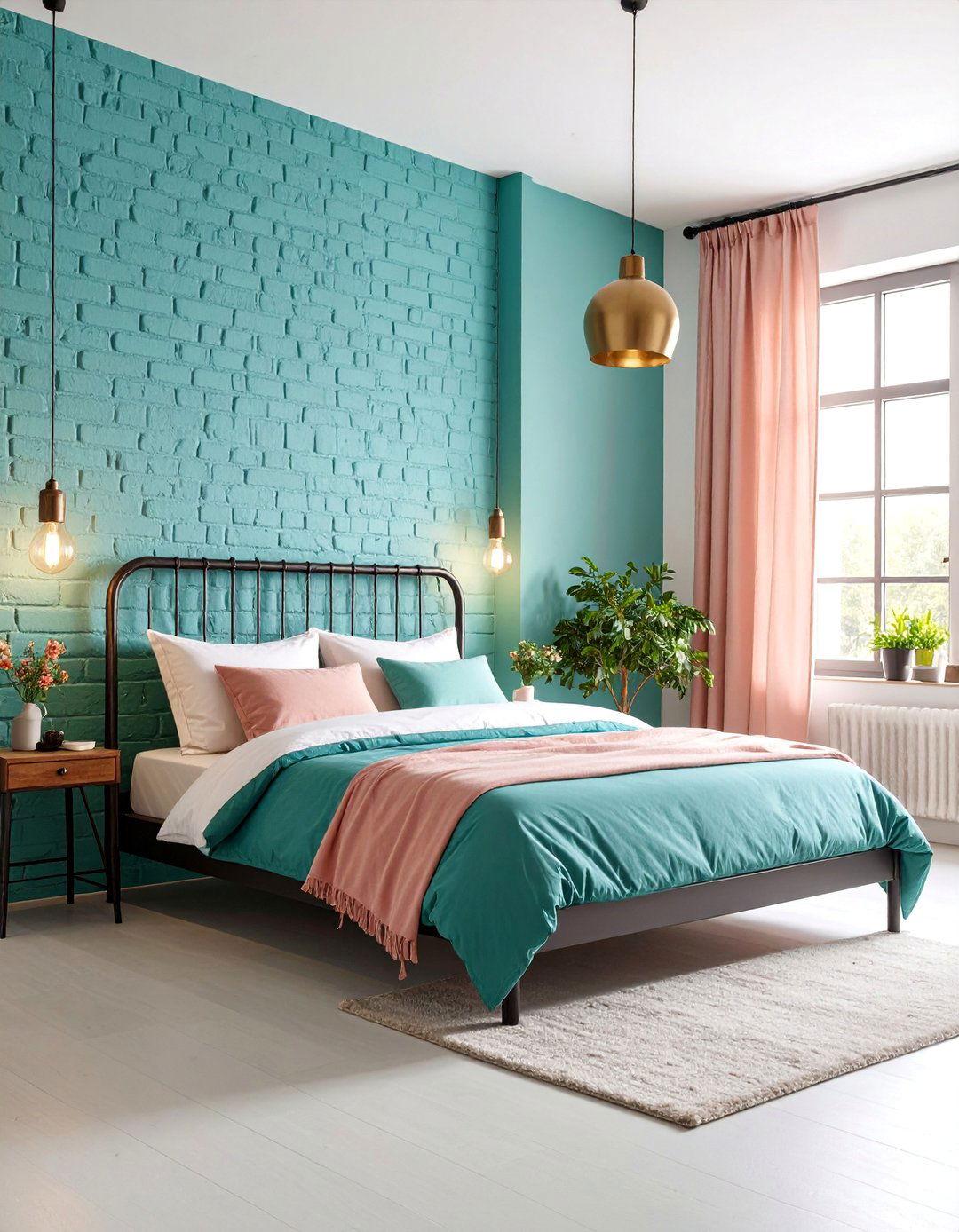
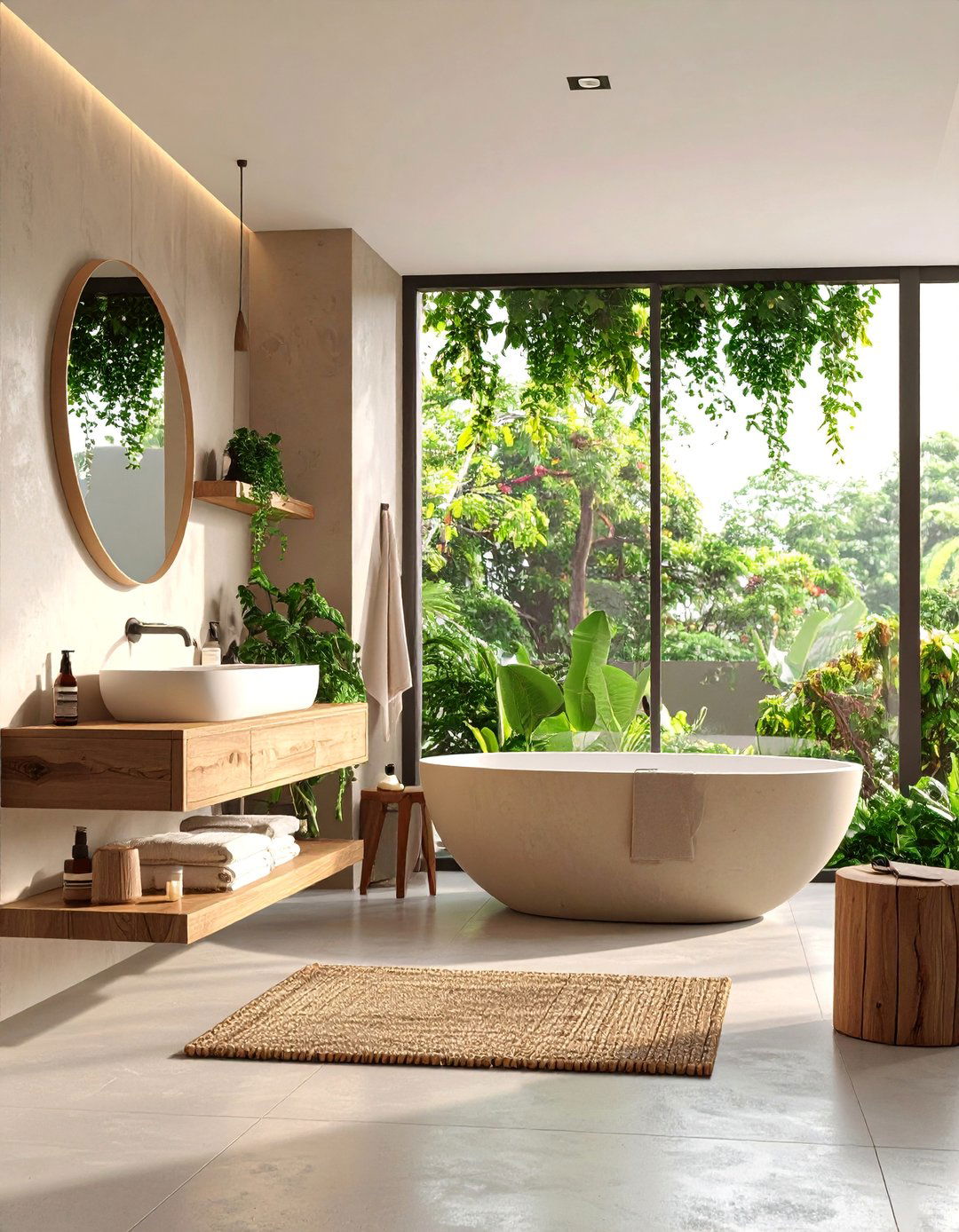
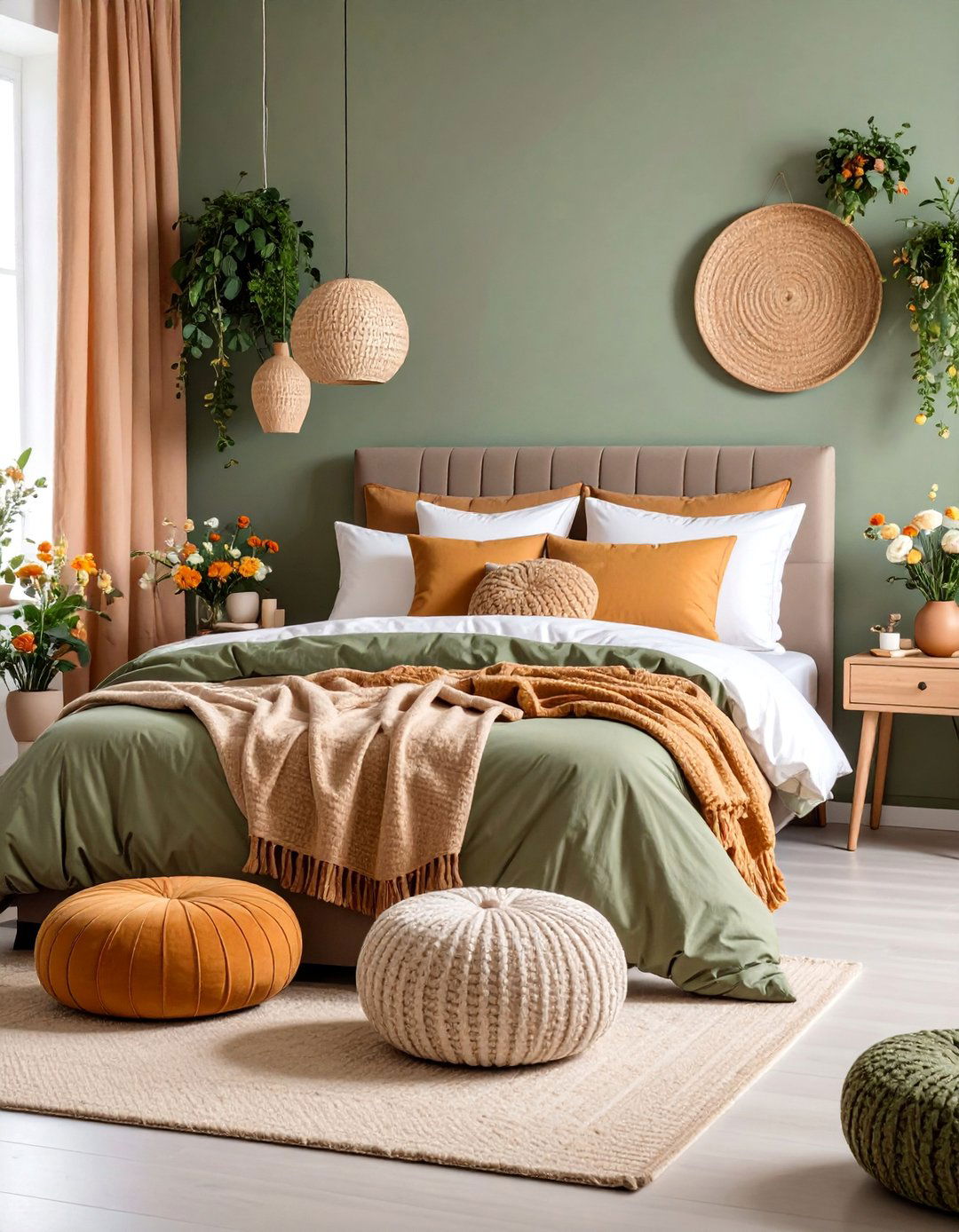

Leave a Reply